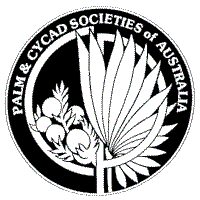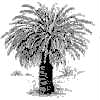|
Cycads
Lepidozamia peroffskyana III |

| |||
|
| ||||
|
Pollination:
A recent study into the pollination of female
L. peroffskyana
cones, by John Hall, in the
form of a thesis which comprised an integral part of his Batchelor of Science (Honours) degree
(Department of Botany, University of Queensland), has proven beyond doubt, as a result of observations
and experiments, that L. peroffskyana
is pollinated exclusively by host specific Tranes sp
.
weevils, which breed in the male cones and "which visit the female cones in large numbers."
In his thesis "Reproductive Ecology of the Australian Cycad Lepidozamia peroffskyana: A Host-Specific Pollination Between a Cycad and a Weevil", John stated that: "The cycad Lepidozamia peroffskyana is pollinated exclusively by the host specific Tranes weevils which carry out their life cycle within the tissues of the male cone and which visit female cones in large numbers. The results of the pollinator exclusion experiment (......) clearly indicate that when Tranes weevils are excluded from L. peroffskyana female cones, the pollination of ovules is essentially reduced to zero. Although several insects exploit L. peroffskyana as a host plant (......) only Tranes weevils are associated with both male and female cones, and hence they represent the only possible candidate for the insect pollination vector."
|
 Figure 12. Tranes sp. weevils congregating on a male cone. |
(1) Tranes weevils congregated in spectacular numbers on male cones of L. peroffskyana some 24 hours before the cones commence to distend; and that one male cone collected for dissection was found to contain more than 700 weevils,
(2) that airborne pollen was not consistently recorded beyond a 2 metre radius surrounding the pollen shedding male cones,
(3) that the pollination of L. peroffskyana cones was effectively zero when Tranes weevils were successfully excluded from gaining access to female cones,
(4) that the results of his study: "unequivocally demonstrated that wind plays no role whatsoever in the pollination of L. peroffskyana ."

Figure 13. Tranes "lyterioides" weevil ex Clyde Mountain.
|
Idiosyncrasies:
As mentioned previously there is a tendency for these plants to branch in some habitat
locations, but rarely in others. It is also noticeable that the average size of plants varies in different
habitat locations for example, plants at Mt Tamborine (in south-eastern Queensland) are generally taller
and more robust than plants at Dorrigo (which is located some 250 kms south of Mt Tambourine), even
though in both locations the plants grow on steep slopes of mountain ranges that are reasonably close to
the ocean. Additionally, plants growing on generally flatter areas near Taree are significantly smaller
than those growing at Dorrigo.
In the Byron Bay area, somewhat unusually for a cycad, L. peroffskyana grows alongside the Australian native palm, Archontophoenix cunninghamiana (the "bangalow" palm). Effect of Fire: L. peroffskyana has adapted to bushfires in the same manner as many other Australian native species. It is often found in State Forests that are subject to programmed cyclic hazard-reduction burn-offs (under the control of experienced Forestry officers). In the aftermath of a bushfire, cones are sometimes produced prior to the emergence of new fronds. Note photo (Figure 14) which shows a male plant with no fronds, but with a distending cone. A female plant can be seen in the background with a mature cone, but also with some newly emerging fronds. |
 Figure 14. Male and female cones emerging after a bushfire. |
 Figure 15. Female cones emerging after a bushfire. |
Propagation:
Propagation is solely from seed, as this species does not normally produce offsets
(suckers) though it is conceivable that a single 'head' removed from the occasional plant, that has
produced multiple 'heads' as a consequence of being damaged, may be able to be successfully
propagated in the same manner as a sucker or an offset from a Cycas revoluta plant.
Conservation: From a conservation point-of-view, this species can be found growing in large dense stands in a number of State Forests, National Parks and vacant Crown Land and is not considered to be at risk. Cultivation: This species, which is probably the most widely cultivated New South Wales cycad, requires no special treatment, in either the garden or a container, to produce an extremely attractive and graceful specimen. It is fast growing and will flourish in well drained soil, preferably (but not essentially) in filtered sun, with moderate applications of fertiliser and reduced watering during winter months. Pest problems are similar to those encountered with other cycads. Scale is not uncommon in plants in cultivation (particularly indoor plants), but is treatable with applications of White Oil. |
Trunk Boring Weevils: Trunk boring weevils, such as Melotranes internatus (Figure 17) and Demyrsus meleoides (Figure 16), that are inadvertently introduced into a home garden environment, can cause massive collateral destruction to seedlings and mature plants in either pots or in the ground.
These weevils are often found in 'sick' or damaged L. peroffskyana plants in the wild; and sometimes in healthy plants in habitat locations though they do not appear to cause any permanent damage to such healthy plants. Unhealthy plants appear to be used as breeding chambers and the resulting larvae feed on plant tissue, making small tunnels as they proceed, culminating in a honeycomb-type pattern of tunnels that cause surrounding areas of the caudex to begin to rot with the ultimate effect on the plant being terminal.
In a home garden environment, the first obvious sign of weevil predation normally occurs when an apparently healthy plant suddenly collapses at ground level, because the caudex has totally rotted.

Figure 16. Demyrsus meleoides weevil specimen.
The damage that can be caused to cycads by Melotranes internatus (previously Tranes internatus ) was the subject of an article on "Cycad-Insect Relationships" which I contributed to Issue No 34 of "Palms & Cycads." In this article mention was made of a report that appeared in Volume 3, Issue No 2 of the Cycad Newsletter in February 1982, concerning the arrival of a weevil (then) identified as Tranes internatus into the U.S. in the late 1960's and 1970's in the caudices of Australian Macrozamias and to significant problems that subsequently occurred in Los Angeles.
The above report indicated that these weevils were unaffected by their host caudex being subjected to methyl bromide fumigation. Obviously the methyl bromide had not penetrated deep enough in the caudices to affect the weevils.
Further historical evidence of the activities of Melotranes internatus is available by reference to an article written, over 120 years ago, in 1886, by J. O. Westwood in a Belgian Entomology Journal. In his article, Westwood described the ravages caused by larvae (then) identified as Tranes internatus which had been found in the caudex of an imported Australian cycad in the city of Ghent. The relevant plant which was described as "Zamia corallipes" was probably either M. spiralis or M. communis , though there is insufficient evidence in the article to now positively identify the particular Macrozamia species involved.
Melotranes internatus was thus capable of surviving a lengthy surface voyage to Europe in the 1880's and, also, withstanding methyl bromide fumigation treatment after caudices were imported into the U.S.A and, in both situations, was able to reproduce in a new and different environment.

Figure 17. Melotranes internatus weevil and larva.
Three conclusions about Melotranes internatus can be drawn from the above:
(1) that adult weevils live deep inside cycad caudices, possibly in tunnels created by larvae, and can resist most normal insecticide/fumigation treatments,
(2) that when removed from their own environment, the weevils are isolated from their natural enemies (if any) and are able to freely multiply, and
(3) that there may be an extremely long interval of time between the arrival of Melotranes internatus in a home garden and its emergence as an identifiable problem.
Care should be taken to prevent these weevils from being introduced into a home garden environment by avoiding purchasing (or otherwise acquiring) plants that are suspected of having been taken from the wild. In addition, a careful examination of nursery-bought plants should also be undertaken before they are introduced into a home garden environment.
Having seen evidence of Melotranes internatus on L. peroffskyana plants, it is my opinion that the purchase of L. peroffskyana plants taken from the wild (or the taking of any cycads from the wild) is somewhat like a lottery, with the chance that if you happen to end up with a plant that is infested with Melotranes internatus , you may unknowingly have a mini-ecological 'time bomb' on your hands.
Affinities: L. peroffskyana is closely related to (but much smaller than) L. hopei , the only other member of the genus. The much broader and marginally darker fronds of L. hopei render the two species easily identifiable?
(Note: This article is a further revised version of two previous articles that I have written about Lepidozamia peroffskyana . The first article was printed in Vol No. 38 of Palms & Cycads in January 1993; and a revised article was printed in Vol No. 107 of Principes minor in July 2002).
| Acknowledgements: | |
|
I would like to thank Rolf Oberprieler, from CSIRO Entomology, for his expert advice about
weevils and, also, for allowing me to reproduce photographs of various weevils.
I would like to congratulate John Hall for his pioneering studies relating to the pollination of L. peroffskyana ; and, also, to thank him for providing me with copies of both his theses. I would also like to thank Craig Thompson for freely sharing his vast botanical knowledge with me. Over a long period of time, Craig and I have visited habitat locations for most New South Wales cycads. Craig and I have also been privileged to escort a number of overseas visitors to various cycad habitat locations in New South Wales, including: Cynthia and Ted Giddy (1984); Loran Whitelock (1985); Cynthia Giddy with Elsa and Piet Vorster (1990); and Piet Vorster with Wynand van Eeden (2006). Finally, I would particularly like to thank my wife, Margaret, and Craig's wife, Nurelle, for their understanding and support as Craig and I ventured off infrequently (or too frequently, perhaps!) into the back of beyond, looking for cycads.
| |
| References: | |
| John Hall. (2000) Relationships between Cycads and Insects: Their Ecological and Evolutionary Significance. | |
| John Hall. (2001) Reproductive Ecology of the Australian Cycad Lepidozamia peroffskyana: A Host-Specific Pollination Symbiosis Between a Cycad and a Weevil. | |
| Contributed by: | Paul Kennedy (Text) |
| Craig Thompson and Paul Kennedy (Figures 1-15) | |
| Rolf Oberprieler (Figures 16&17) |
| <<< Previous |
| For further information try | |||||||||
 |
 |
|
VCE |
 |
 |
||||
 |
 |
 |
 |
 |
 |
||||